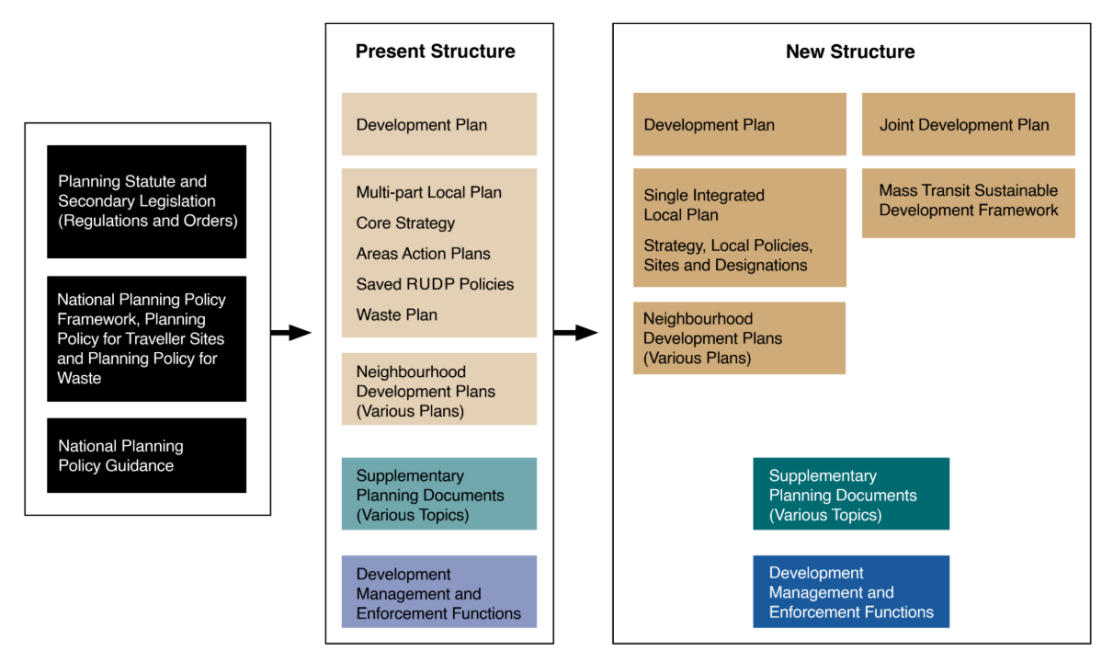Statement of Community Involvement 2025
1. Introduction
This chapter is an introduction to the Statement of Community Involvement 2025.
If you'd like to leave a comment you can do so by answering the question at the bottom of the page.
1.1 What is the Statement of Community Involvement?
1.1.1 The Statement of Community Involvement (SCI) is a statutory document that sets out how and when the Council will carry out consultation and effectively engage with communities and stakeholders in carrying out its planning duties.
1.1.2 The Council is required, by law, to have an adopted SCI as per the Planning and Compulsory Purchase Act (2004) (as amended) and review and update the statement every 5 years.
1.2 Why is Planning Important?
1.2.1 The overriding purpose of the planning system is to help achieve sustainable development by enabling development that benefits not only the existing, but future communities. Planning directly affects our physical environment, where we live and work, relax and spend time and resources.
1.2.2 It also shapes how we travel and can play a major role in tackling climate change influencing our quality of life and general well-being. High quality new development can also benefit communities through the provision of housing, employment opportunities and new facilities together with investment in infrastructure.
1.2.3 Effective community and stakeholder engagement is central to good planning. Being part of the planning process means that Bradford's communities can play an active role in shaping places and neighbourhoods and be involved in the decision-making process.
1.3 Defining Communities and Engagement
1.3.1 A community is a group of people living in the same place or having a particular characteristic, attitude or interest in common. The Council acknowledges that a community can be defined in different ways including communities of interest (specific interest groups for example), place (neighbourhoods and villages are examples) and according to themes ( health, education, environment for example).
1.3.2 Community engagement can also mean different things to different people. Bradford Council has defined community engagement as: 'The involvement of citizens, through locally based representative bodies and individually, in influencing and shaping those decisions which directly impact on their local environment, the services they receive and the quality of their daily life'.
1.3.3 At a practical level community engagement can apply different methods and levels or stages of engagement. Community engagement methods range from at one end of the spectrum informing and listening through to consulting and involving communities and then to more intense methods of collaboration and empowering. Participants in community involvement can include a range of activities from information and research gathering through to surveys and consultation to participation in decision-making and feedback on projects, programmes and policies.
1.3.4 The methods and tools available for community engagement is considerable from traditional information sharing through libraries and other information points to online material and face to face meetings. Not all tools will be applicable or useful in all cases and taking a focused tailored approach to community engagement is central to the SCI. This is explored more fully within Part 2.
1.4 Reviewing the Statement of Community Involvement
1.4.1 This revised Statement of Community Involvement sets out how Bradford Council will engage with local communities, stakeholders and other interested parties during:
- the preparation of its planning policy and supplementary planning documents;
- in support of neighbourhood planning, and
- through the consideration of planning applications.
1.4.2 The production of this SCI takes place within the context of rapidly changing societal context heightened by the further acceleration of digital communication with access to multiple channels of online information, questions over the validity of information and with the increased use of Artificial Intelligence (AI). Planning is also changing through new legislation and regulations with a strong focus upon digital planning, local spatial planning and early community engagement with fewer formal stages and faster working methods.
1.4.3 In compliance with the General Data Protection Regulations (GDPR) (2018), the Council's Planning Service has privacy notices set out for the Local Plan and Development Services.

1.5 Supporting Equality and Diversity
1.5.1 The Council is committed to making the planning system in Bradford as inclusive and representative as possible.
1.5.2 The Government introduced the Equality Act in 2010 which brought together nine separate pieces of legislation into one single Act simplifying the law and strengthening it in important ways to help tackle discrimination and inequality.
1.5.3 The Public Sector Equality Duty, which is part of the Equality Act 2010, came into effect on 5th April 2011. The Council must, in the exercise of its functions, have due regard to the need to:
- Eliminate discrimination, harassment, victimisation and any other conduct that is prohibited by or under this Act
- Advance equality of opportunity between persons who share a relevant protected characteristic and persons who do not share it
- Foster good relations between persons who share a relevant protected characteristic and persons who do not share it
1.5.4 The Duty covers the following nine protected characteristics, plus two additional set by the Council:
- Age
- Disability
- Gender reassignment
- Pregnancy and maternity
- Race
- Religion or belief
- Sex (Gender)
- Sexual Orientation
- Marriage and Civil partnership (but only in regard to eliminating discrimination)
- Low income / low wage (Council's additional consideration)
- Care leavers (Council's additional consideration)
1.5.5 As part of the preparation of the Local Plan and planning policy documents, the Council undertakes and produces Equality Impact Assessments (EqIAs) on proposed policies, plans or programmes to ascertain if there is likely to be any potentially adverse impacts upon any protected characteristic group, and if so how any impacts will be mitigated.
1.5.6 An Equality Impact Assessment (EQIA) has been produced alongside this SCI. This is a supplementary document and can be found on the Council's webpage.
1.6 The Planning System – National Context
1.6.1 The purpose of the planning system is to contribute to the achievement of sustainable development, including the provision of homes, commercial development and supporting infrastructure in a sustainable manner. At a very high level, the objective of sustainable development can be summarised as meeting the needs of the present without compromising the ability of future generations to meet their own needs.[1]
1.6.2 Local Planning Authorities (LPAs) administer much of the planning system, set out in planning legislation and through the National Planning Policy Framework (NPPF) and Guidance (NPPG).
1.7 Key Local Planning Functions
1.7.1 The key planning functions for Bradford of relevance to the SCI are:
- Plan-making – which sets out policies, allocations and designations to guide development and planning decisions.
- Supplementary planning documents – provision of further guidance on how local planning policies should be implemented.
- Determining planning applications – decisions on whether proposed developments should receive planning permission, based on adopted planning policies, national policy and other material considerations.
- Planning enforcement – investigating planning enforcement breaches. LPAs are responsible for tackling unauthorised development and stopping levels of unacceptable development.
- Supporting neighbourhood planning – the Council has a duty to support communities who wish to set out their own vision for their local area and supporting planning policies through the production of a statutory Neighbourhood Development Plan (NDP)
1.7.2 Figure 1 below provides an overview of the national and local planning context. The development plan overall consists of both local plan related documents and neighbourhood plans.
Figure 1: Changing Development Plan Context

1.8 Plan-making
1.8.1 The Planning system in England is 'plan-led'. LPAs must prepare and have an up-to-date Local Plan for their area covering a specific plan-period. Local planning documents and policies are used to help manage and shape development in an area. Local Planning documents must conform with the national planning policy (NPPF) and guidance (NPPG).
1.8.2 One of the foundations of plan-making as set out in the NPPF is that plans should be shaped by early, proportionate and effective engagement between plan-makers and communities, local organisations, businesses, infrastructure providers and operators and statutory consultees.
1.8.3 The policy framework for Bradford's current development plan is complex but the adopted Local Development Scheme (LDS) sets out to simplify the overall plan-making structure in developing a new single integrated local plan with supplementary planning documents where relevant.
1.9 Development Management and Enforcement
1.9.1 LPAs are responsible for development management which involves the processing and determination of planning applications, alongside providing pre-application advice and investigating breaches of planning consent within the Bradford District.
1.9.2 It is important to note that not all forms of development require planning permission from the Council. Some types of development, such as some change of uses, extensions, or alterations, are covered by 'permitted development rights'. They are granted planning permission through a Development Order by Central Government. Further advice on these can be found on the planning portal or on the Council's web pages.
1.9.3 The Enforcement Service is part of the Local Planning Authority which deals with complaints about alleged unauthorised developments/uses, the display of advertisements without consent, non-compliance with planning conditions and unauthorised works or demolition of listed buildings. Due to the volume of complaints, the Council's enforcement priorities are focused upon:
- Matters concerning Health & Safety and significant nuisance (significant nuisance is defined as an activity, building or other structure which by its presence has, or is likely to have, an adverse effect on residential, working or visual amenity in the surrounding area)
- Listed Buildings, Conservation Area and trees protected by a Tree Preservation Order(s)
- Transport Corridors, Gateways and High Public Amenity Areas
- Issues that have an adverse impact on the street scene.
1.10 Range of Council Functions
1.10.1 The City of Bradford Metropolitan District Council (CBMDC) is a unitary Local Authority and so are responsible for the preparation of a Local Plan, management of planning control, building control, highways and transport, education, waste management and flooding.
1.10.2 It is important to note that during the life of this document there may be further planning reforms or changes to planning regulations and policy which may influence the way in which consultations are conducted. Any changes will be communicated at the time of consultation. The SCI may also require updates when any planning reforms or changes take effect.
Please use the buttons below to either support or object with comments or simply provide comments including any suggested changes to this chapter. You can also upload supporting information.
[1] Resolution 42/187 of the United Nations General Assembly

